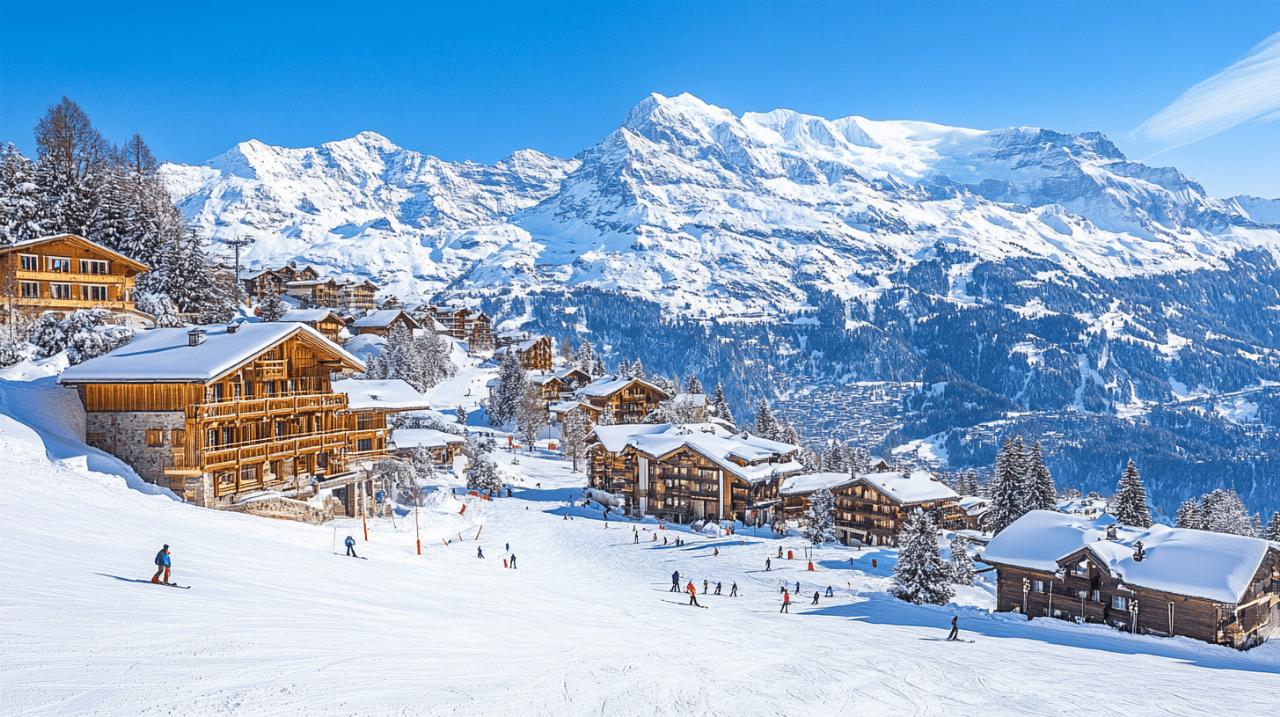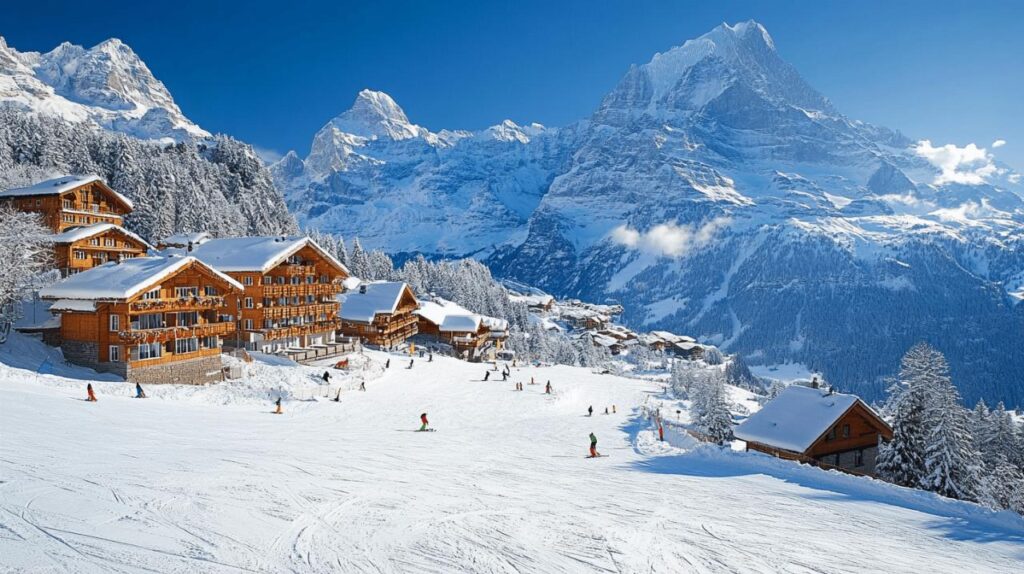Switzerland's ski resorts represent far more than mere winter destinations; they embody a legacy woven through centuries of exploration, royal favour, and the relentless human desire to conquer the high peaks. These alpine sanctuaries have evolved from humble health retreats and adventurous experiments into the epitome of luxury, sporting excellence, and environmental stewardship. From the car-free villages perched above ancient glaciers to the glamorous hubs that have hosted Olympic glory, the Swiss Alps offer a narrative as captivating as the panoramas themselves. The journey through these resorts is a voyage through time, where Victorian curiosity gave birth to an enduring tradition of alpine excellence that continues to inspire visitors from across the globe.
From victorian pioneers to modern alpine retreats: switzerland's skiing heritage
The Birth of Alpine Tourism and Early British Adventurers
The story of Swiss skiing begins not with skis, but with an audacious wager in 1864. Johannes Badrutt, proprietor of the Faller pension in St Moritz, challenged a group of British tourists with a bold proposition: that the alpine town basked in more sunshine during winter than even London could muster. If his guests found the conditions disagreeable, he would personally cover their travel expenses. The Britons accepted, and to everyone's delight, they remained until Easter, enchanted by the crisp mountain air and brilliant sunshine. This single act of confidence sparked the birth of winter tourism in the Alps, transforming sleepy mountain villages into destinations of international repute. The early visitors did not ski in the modern sense; instead, they fashioned their own amusements, playing golf, polo, tennis, and cricket upon the snow. Most famously, they invented tobogganing, an activity that became so popular it led to the establishment of the Tobogganing Club and the legendary Cresta Run. Though the Cresta Run became a male-only preserve from 1929 onwards, its reputation as a daring descent endures to this day. These pioneering adventurers laid the groundwork for an industry that would reshape the Swiss economy and culture, turning remote hamlets into bustling resorts.
How royal patronage shaped switzerland's premier ski destinations
Royal and aristocratic patronage played a pivotal role in elevating Swiss resorts from rustic curiosities to the pinnacle of European winter society. St Moritz, in particular, became synonymous with wealth and prestige, hosting the Winter Olympics in 1928 and again in 1948, as well as the World Ski Championships on five separate occasions, including as recently as 2017. The resort's allure attracted not only athletic glory but also astonishing displays of opulence. In one notable instance, a family reserved forty-six rooms at the Kempinski Palace, including the presidential suite priced at twelve thousand pounds per night, for an entire fortnight. Such extravagance underscored the resort's status as a playground for the elite. In 1968, shipping magnate Stavros Niarchos acquired the Kulm hotel to prevent its acquisition by Club Med, a move that preserved the resort's exclusive character. Even today, foreign residents comprise thirty-eight per cent of St Moritz's population of over five thousand, and half of all properties serve as second homes. Modern condominiums command rental rates of one hundred thousand Swiss francs per week, a testament to the enduring cachet of this alpine jewel. The presence of royalty and the ultra-wealthy has ensured that Swiss resorts maintain impeccable standards, from their lift infrastructure to their hospitality offerings, cementing their reputation as the finest winter destinations in the world.
Saas-Fee and Val d'Anniviers: Timeless Beauty in the Swiss Alps
Saas-fee's glacier paradise: where history meets high-altitude skiing
Saas-Fee stands as a testament to the harmonious balance between environmental consciousness and world-class skiing. This car-free village nestles among thirteen peaks that soar above four thousand metres, creating a natural amphitheatre of staggering proportions. The resort's commitment to sustainability, combined with slopes that reach an impressive three thousand five hundred metres, ensures that skiing is possible throughout the entire year, a rarity even in the high Alps. The terrain around Saas-Fee offers not only excellent groomed pistes totalling one hundred kilometres but also an impressive array of off-piste opportunities for those seeking adventure beyond the marked runs. The village's pedestrian-only streets contribute to an atmosphere of tranquillity, where the hum of electric vehicles and the crunch of snow underfoot replace the roar of combustion engines. For beginners, Saas-Fee offers gentle slopes and patient instructors, while advanced skiers can test their mettle on challenging descents and explore the vast, untouched powder fields that characterise the upper reaches of the resort. The combination of high altitude, reliable snow conditions, and a commitment to preserving the natural environment makes Saas-Fee a destination that respects both tradition and innovation, appealing to families, eco-conscious travellers, and seasoned alpinists alike.
Val d'anniviers: the postcard-perfect valley that time forgot
Val d'Anniviers, particularly the village of Grimentz, offers a glimpse into a Switzerland that has resisted the relentless march of modernisation. This valley, with its charming villages and traditional wooden chalets, provides a haven for families and powder enthusiasts seeking authenticity and value. Grimentz boasts one hundred and fifteen kilometres of pistes, the majority of which lie above two thousand metres, ensuring excellent snow conditions throughout the season. Unlike some of the more famous resorts, Grimentz offers exceptional value, making it accessible to skiers who might find the prices of St Moritz or Zermatt prohibitive. The terrain caters to a wide range of abilities, with gentle slopes for beginners and intermediate skiers, as well as steeper, more challenging runs for those with greater experience. The village itself retains a timeless quality, with narrow streets, ancient granaries, and a genuine sense of community that is increasingly rare in heavily commercialised resorts. Visitors to Val d'Anniviers often remark on the sense of stepping back in time, where the rhythms of mountain life remain largely unchanged by the demands of modern tourism. This combination of scenic beauty, reliable snow, and authentic alpine culture makes Val d'Anniviers a cherished secret among those in the know, a place where the essence of traditional Swiss mountain life endures.
Crans-Montana to Klosters: Resorts Steeped in Tradition and Breathtaking Vistas
Crans-montana's panoramic splendour and belle époque charm
 Crans-Montana commands some of the most spectacular vistas in the entire alpine chain, with over one hundred and forty kilometres of ski runs stretching between one thousand five hundred and three thousand metres. The resort benefits from over three hundred days of sunshine per year, a statistic that rivals even St Moritz and contributes to the crisp, clear conditions that make skiing here such a pleasure. The terrain at Crans-Montana is particularly well-suited to intermediate and advanced skiers, with a good selection of challenging red and black runs, as well as opportunities for ski touring. The resort's Belle Époque architecture and elegant hotels evoke a bygone era of refined alpine leisure, when guests arrived by steam train and spent entire seasons in mountain grand hotels. In recent years, Vail Resorts acquired a significant stake in Crans-Montana and has pledged substantial investment to modernise lift infrastructure and expand facilities, ensuring that the resort remains competitive with the best in the world. This infusion of capital, combined with the resort's natural advantages, positions Crans-Montana as a destination poised for continued growth and excellence. The proximity to Geneva International Airport, just one hundred and fifteen miles away, makes access straightforward, allowing visitors to transition from urban bustle to alpine serenity in a matter of hours.
Crans-Montana commands some of the most spectacular vistas in the entire alpine chain, with over one hundred and forty kilometres of ski runs stretching between one thousand five hundred and three thousand metres. The resort benefits from over three hundred days of sunshine per year, a statistic that rivals even St Moritz and contributes to the crisp, clear conditions that make skiing here such a pleasure. The terrain at Crans-Montana is particularly well-suited to intermediate and advanced skiers, with a good selection of challenging red and black runs, as well as opportunities for ski touring. The resort's Belle Époque architecture and elegant hotels evoke a bygone era of refined alpine leisure, when guests arrived by steam train and spent entire seasons in mountain grand hotels. In recent years, Vail Resorts acquired a significant stake in Crans-Montana and has pledged substantial investment to modernise lift infrastructure and expand facilities, ensuring that the resort remains competitive with the best in the world. This infusion of capital, combined with the resort's natural advantages, positions Crans-Montana as a destination poised for continued growth and excellence. The proximity to Geneva International Airport, just one hundred and fifteen miles away, makes access straightforward, allowing visitors to transition from urban bustle to alpine serenity in a matter of hours.
Klosters: the royal favourite and its enduring appeal
Klosters has long held a special place in the hearts of discerning skiers, not least because of its status as a favourite retreat of the British Royal Family. This association with royalty has lent the resort an air of exclusivity without the overt ostentation that characterises some of its neighbours. Together with Davos, Klosters forms a twin resort system offering over three hundred kilometres of slopes spread across six distinct areas. While Davos caters primarily to intermediate and advanced skiers with its more challenging pistes, Klosters offers terrain suitable for all levels, making it an ideal choice for families and mixed-ability groups. The village itself retains a quiet, understated charm, with traditional chalets and a pedestrian-friendly centre that encourages leisurely strolls and après-ski relaxation. The quality of the skiing at Klosters is exceptional, with well-maintained pistes, efficient lift systems, and a variety of terrain that ensures no two days on the mountain feel the same. The resort's popularity with the British aristocracy has not led to overcrowding or over-commercialisation; instead, Klosters has maintained a careful balance between accessibility and exclusivity. For those seeking a resort that combines royal pedigree with genuine alpine authenticity, Klosters remains an unmatched choice, a place where tradition and quality continue to define the visitor experience.
Davos and St. Moritz: Icons of Swiss Alpine Grandeur Through the Ages
Davos: from health sanatorium to world-class ski resort
Davos occupies a unique position in alpine history, having evolved from a health sanatorium into one of the world's most famous ski resorts and the host of the annual World Economic Forum. The town's elevation and dry climate made it a favoured destination for tuberculosis patients in the nineteenth century, a medical function that gave Davos its initial prominence. As winter sports gained popularity, Davos embraced its new identity, developing extensive lift systems and piste networks that now encompass over three hundred kilometres of varied terrain. The skiing at Davos is characterised by its diversity, with slopes that range from gentle beginner runs to steep, technical descents that challenge even the most accomplished skiers. The resort's infrastructure is among the most advanced in the Alps, with high-speed lifts and modern gondolas ensuring efficient access to all areas of the mountain. The combination of historical significance, world-class skiing, and the international prestige conferred by hosting the World Economic Forum has made Davos a resort that transcends simple winter sports, embodying instead a broader vision of alpine culture and global engagement. The proximity to Klosters allows visitors to enjoy the best of both resorts, with the lively, cosmopolitan atmosphere of Davos complementing the quieter, more traditional character of its neighbour.
St. Moritz: The Cradle of Alpine Winter Tourism and Luxury
St. Moritz rightfully claims the title of the birthplace of Alpine winter tourism, a status confirmed by the events of 1864 and cemented by over a century and a half of continuous innovation and excellence. The resort's hosting of the Winter Olympics in both 1928 and 1948, along with five World Ski Championships, demonstrates its enduring capacity to stage events of global significance. With over three hundred kilometres of pistes served by forty-two lifts, and slopes that ascend beyond three thousand metres, St. Moritz offers skiing on a grand scale. The terrain is varied enough to satisfy all levels of skier, though the resort's reputation and pricing tend to attract a more affluent clientele. The town itself is a showcase of luxury, with grand hotels, high-end boutiques, and restaurants that rank among the finest in Europe. Beyond skiing, St. Moritz offers a wealth of winter activities, including ice polo, bobsledding on the famous Olympic track, and the previously mentioned Cresta Run. The resort's commitment to maintaining its position at the pinnacle of alpine tourism has led to continuous investment in infrastructure, hospitality, and environmental sustainability. St. Moritz is not merely a ski resort; it is an institution, a place where history, sport, and luxury converge to create an experience that remains unmatched in the alpine world. For those seeking the very best that Swiss skiing has to offer, St. Moritz stands as the ultimate destination, a place where the past and present coexist in perfect harmony.



